Cursor Alternatives in 2025: Find the Best AI Coding Assistant for Your Workflow
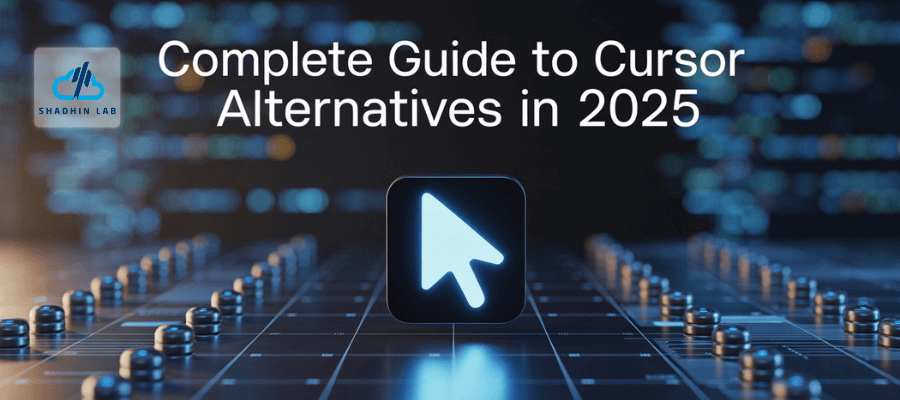
Table of Contents
Are you feeling constrained by your current coding tools? Have you been exploring Cursor AI but wondering if there might be better options tailored to your specific development needs? You are not alone in this search.
What if finding the right Cursor alternative could dramatically transform your coding efficiency and overall development experience? By the end of this comprehensive guide, you will discover options that might better align with your unique workflow requirements.
Let us explore the landscape of Cursor Alternatives together, examining what makes each option uniquely valuable for different development scenarios.
Key Takeaways
Readers will know the strengths, limitations, and unique value of Cursor alternatives, along with guidance to choose the right AI coding assistant.
- Understand what Cursor AI is, how it works, and why developers often explore alternatives.
- Identify the key reasons to look beyond Cursor, including language support, collaboration, debugging, pricing, and enterprise readiness.
- Compare essential features like language coverage, AI code quality, IDE integration, collaboration, and pricing across top alternatives.
- Discover the leading Cursor alternatives in 2025—GitHub Copilot, JetBrains AI Assistant, Tabnine, Amazon CodeWhisperer, Codeium, and Sourcegraph Cody.
- Evaluate how these tools stack up against Cursor in usability, coding capabilities, integrations, pricing, and team scalability.
- Choose the best fit for individuals, startups, or enterprises by aligning features, project complexity, budget, and long-term scalability with your workflow.
Table of Contents
What is Cursor AI?
Have you ever wished for an intelligent assistant that could help you write code faster and more efficiently? Cursor AI represents exactly that kind of revolutionary development tool.
Cursor is an AI-powered code editor that has quickly gained popularity among developers worldwide. Built on top of Visual Studio Code, it seamlessly integrates powerful AI capabilities to help you write code more efficiently and effectively.
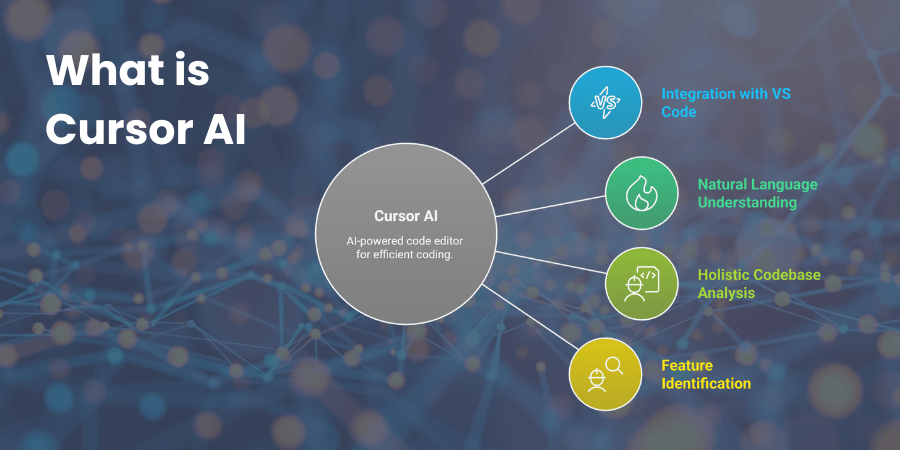
What makes Cursor particularly compelling is its ability to understand your codebase holistically, not just line by line. You can ask questions about your code in natural language or request specific implementations with remarkable results.
Despite its impressive capabilities, you might find yourself wondering if Cursor is truly the optimal fit for your specific development requirements and workflow preferences.
Tip: Before exploring alternatives, take time to identify exactly what features and capabilities you need from an AI coding assistant for your specific projects.
Why Look for Cursor Alternatives?
Are you discovering that Cursor does not fully address all your development requirements? Many developers initially embrace Cursor but eventually identify specific limitations that prompt them to explore other options.
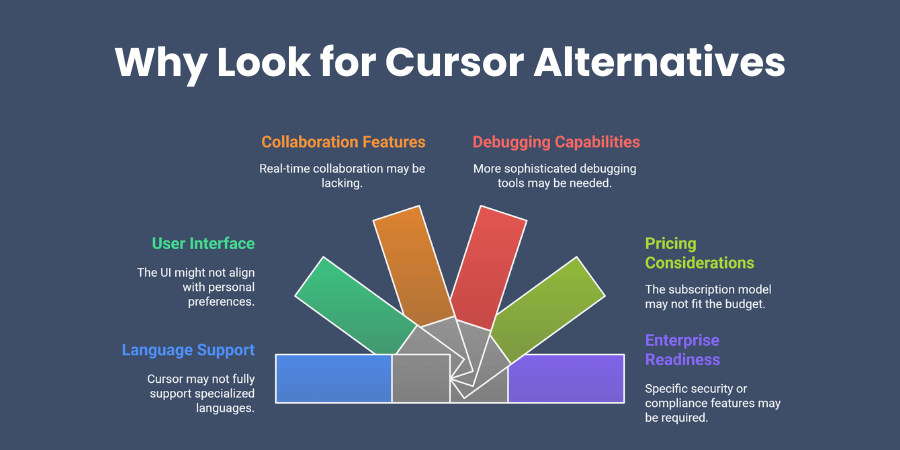
You might be seeking Cursor Alternatives because of language support constraints. While Cursor excels with popular programming languages, you may work with specialized languages that receive less comprehensive support.
Perhaps the user interface does not align perfectly with your preferences. You might prefer a different layout or visual design that feels more intuitive to your established working style.
Collaboration features could be another significant consideration in your experience. Do you work in a team environment where real-time collaboration and code sharing are essential components?
What about debugging capabilities? You may require more sophisticated debugging tools that provide deeper insights into your code execution and error identification.
Pricing considerations often drive the search for alternatives as well. You might find that Cursor’s subscription model does not align optimally with your budget constraints or usage patterns.
Enterprise readiness could be another decisive factor in your evaluation. Your organization might require specific security certifications or compliance features that affect your tool selection process.
Understanding precisely why you are looking beyond Cursor helps narrow your search for alternatives that address your specific needs and priorities.
Tip: Create a prioritized list of features you absolutely need versus those that would be nice to have before evaluating alternatives.
Key Features to Consider in a Cursor Alternative
What specific capabilities should you prioritize when evaluating potential replacements for Cursor? The ideal alternative needs to address your particular pain points and enhance your development workflow.
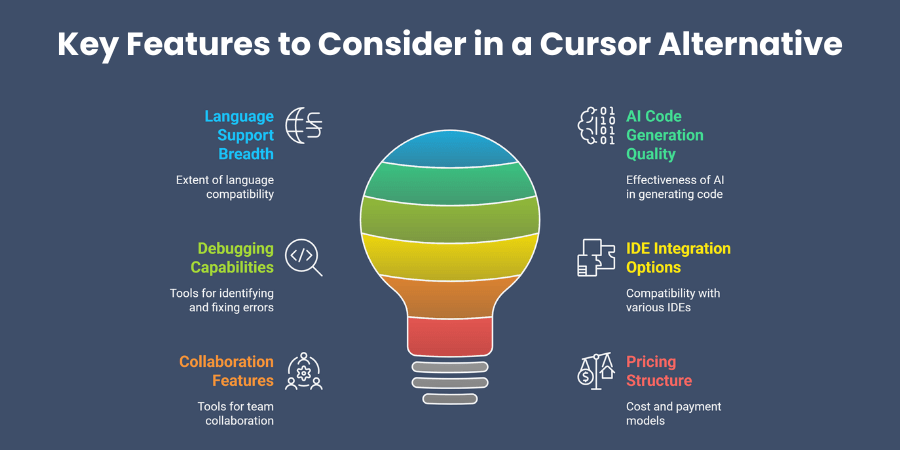
When assessing alternatives, consider these essential factors that will impact your daily coding experience:
Language Support Breadth
How comprehensive is the tool’s language support? You need an assistant that thoroughly understands the languages and frameworks you work with on a regular basis.
AI Code Generation Quality
Have you experienced frustration with inaccurate code suggestions? The quality of AI-generated code varies significantly between tools and can dramatically impact productivity.
Debugging Capabilities
Do you find yourself spending excessive time troubleshooting issues? Look for alternatives with powerful debugging tools that simplify error identification and resolution.
IDE Integration Options
How seamlessly does the tool fit into your existing workflow? The best alternative should integrate smoothly with your preferred development environment without disruption.
Collaboration Features
Are you working in a team environment? Evaluate how well each alternative supports collaborative development practices and knowledge sharing among team members.
Pricing Structure
Does the cost align with your budget and usage patterns? Compare pricing models across alternatives to ensure sustainable value for your investment.
Here is a comparison of these key features across several leading alternatives:
| Feature | Ideal Characteristics | Why It Matters To You |
| Language Support | Comprehensive coverage of mainstream and specialized languages | Ensures the tool works with all your projects regardless of language |
| AI Code Quality | Context-aware, accurate, and up-to-date suggestions | Reduces time spent correcting AI-generated code and improves trust |
| Debugging Tools | Interactive debugging with clear error explanations | Helps you resolve issues faster and learn from mistakes |
| IDE Integration | Works with your preferred development environment | Minimizes disruption to your established workflow |
| Collaboration | Real-time editing and sharing capabilities | Enhances team productivity and code quality |
| Pricing | Flexible options aligned with your usage needs | Ensures good ROI and sustainable usage |
When evaluating these features, consider your specific development context and how each alternative addresses your unique requirements.
Best Cursor Alternatives in 2025
Are you ready to discover which AI coding assistants might better serve your specific development needs? Let us examine the leading options currently available.
1. GitHub Copilot
Have you been looking for an AI assistant with deep integration into the GitHub ecosystem? GitHub Copilot might be your ideal match for seamless GitHub workflow integration.
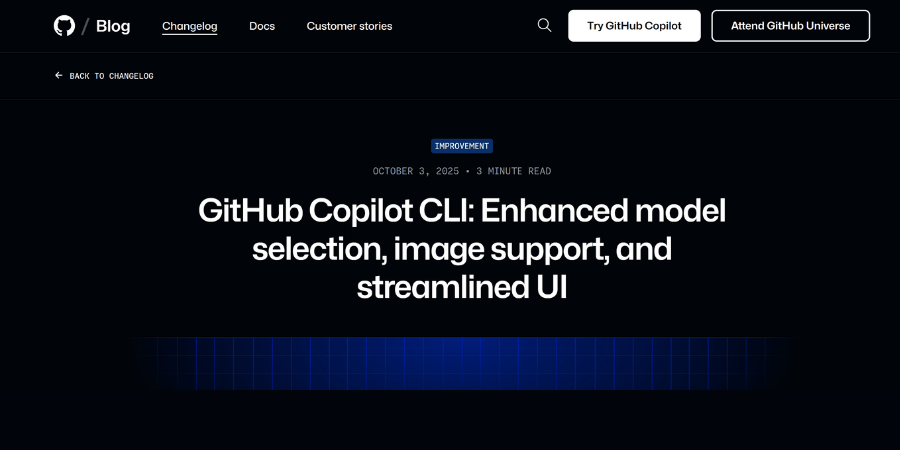
You will appreciate Copilot’s ability to suggest complete functions and blocks of code based on comments or function signatures. Its integration with multiple IDEs makes it accessible regardless of your preferred development environment.
Where Copilot truly excels is in its understanding of popular frameworks and libraries. When you are working with mainstream frameworks, you will notice particularly accurate and contextually appropriate suggestions.
Copilot is especially valuable if you frequently work with open-source projects, as it has been trained on a vast repository of GitHub code with diverse implementation patterns.
2. JetBrains AI Assistant
Do you primarily work within the JetBrains ecosystem? JetBrains AI Assistant provides deeply integrated AI capabilities across the entire suite of JetBrains IDEs for maximum productivity.
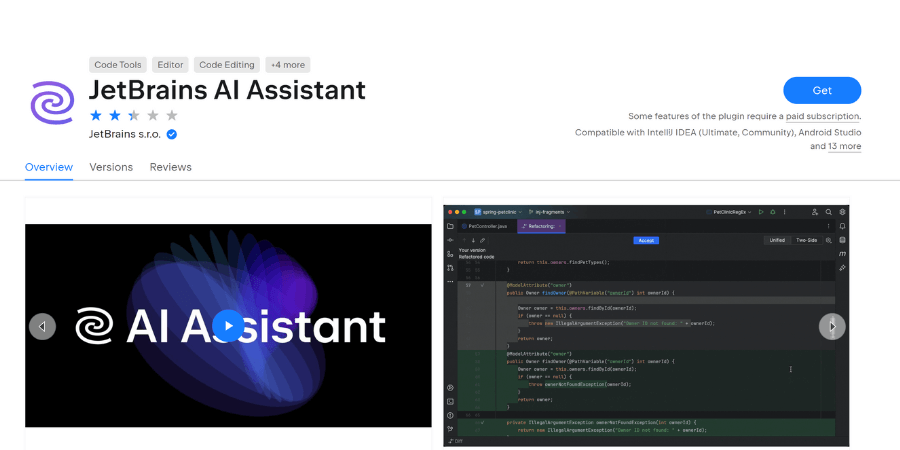
You will find that JetBrains AI Assistant offers particularly strong refactoring suggestions and code explanations. When you encounter unfamiliar code, the assistant provides contextual insights that accelerate understanding.
The tool excels at language-specific optimizations, offering suggestions that align with idiomatic patterns for each programming language you work with.
JetBrains AI Assistant integrates seamlessly with other JetBrains features like debugging tools and version control for a cohesive development experience.
3. Tabnine
Are you concerned about data privacy or need to work in air-gapped environments? Tabnine offers both cloud-based and fully local AI models to address security requirements.
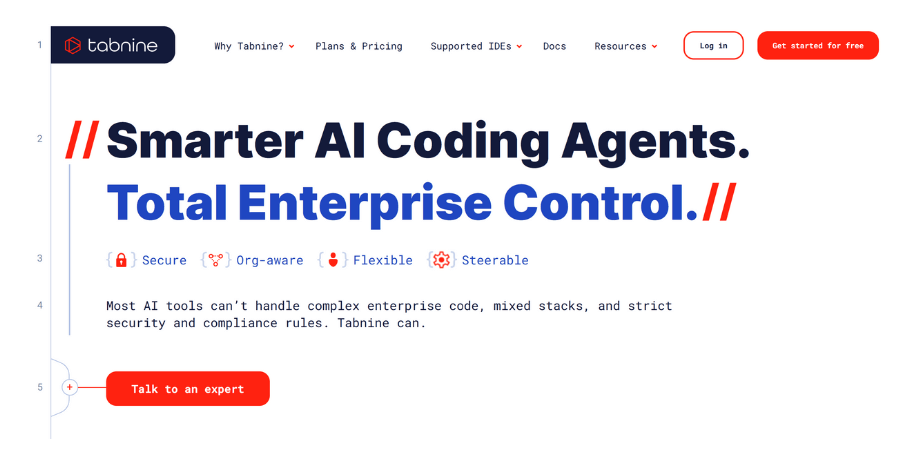
You will appreciate Tabnine’s focus on personalized code suggestions that learn from your coding style over time. The more you use it, the better it adapts to your personal patterns.
Tabnine supports over 30 programming languages and integrates with most popular IDEs, providing flexibility regardless of your technology stack or development environment.
The tool is particularly strong at completing lines and small blocks of code rather than generating entire functions, focusing on precision over breadth.
4. Amazon CodeWhisperer
Do you work extensively with AWS services? Amazon CodeWhisperer might be your ideal solution, with its deep understanding of AWS services and cloud development patterns.
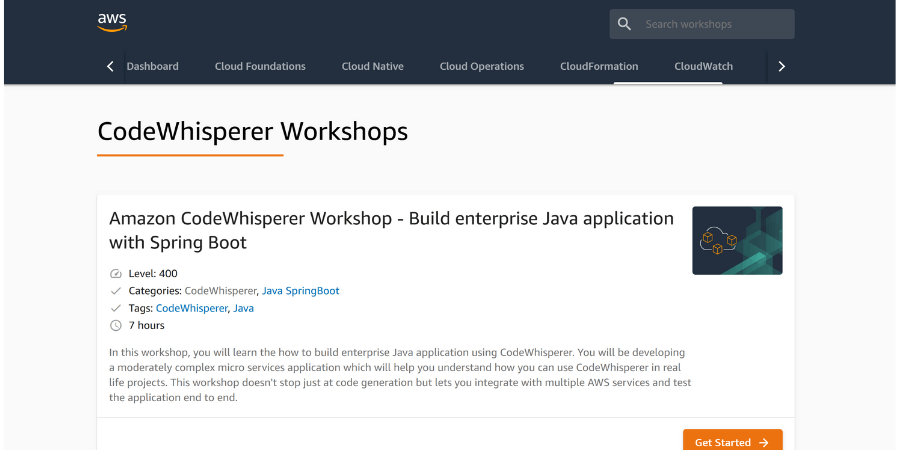
You will find CodeWhisperer particularly helpful when implementing AWS integrations, as it can suggest code that follows best practices for AWS services and cloud architecture.
CodeWhisperer offers strong security scanning features, flagging potential vulnerabilities in generated code and suggesting more secure alternatives for improved application safety.
The tool provides a free tier for individual developers, making it accessible if you are working on personal projects or just beginning your cloud development journey.
5. Codeium
Are you looking for a free alternative with capabilities comparable to premium options? Codeium offers a surprisingly robust free tier with extensive functionality.
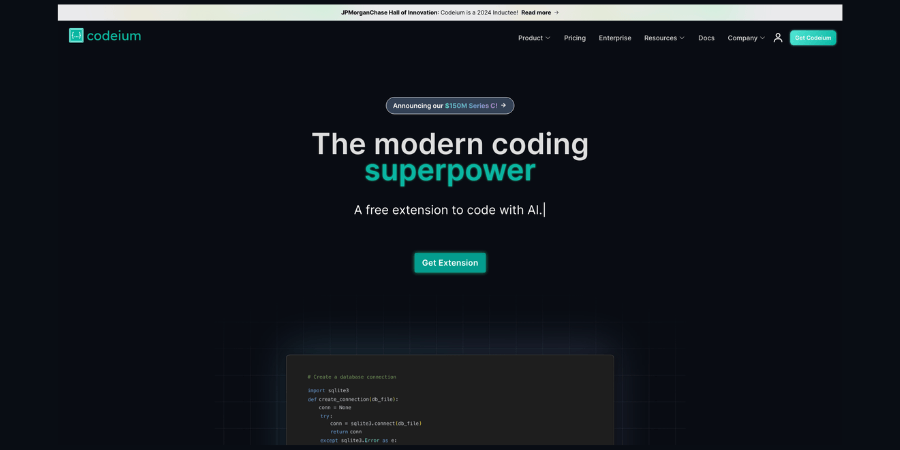
You will appreciate Codeium’s speed, with noticeably faster suggestions than many alternatives. This responsiveness can help maintain your flow state while coding complex solutions.
Codeium supports over 70 programming languages and integrates with more than 20 IDEs, providing exceptional flexibility across diverse development environments.
The tool includes interesting features like natural language to code translation and code explanation capabilities that enhance understanding and productivity.
6. Sourcegraph Cody
Do you work with large, complex codebases where understanding context is crucial? Sourcegraph Cody specializes in code intelligence across massive repositories.
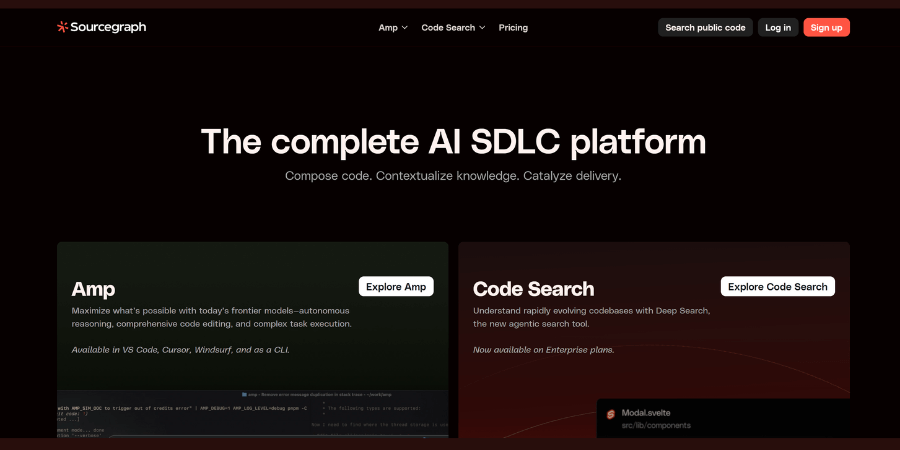
You will find Cody particularly valuable for its ability to answer questions about your codebase and explain functions within their broader context.
Cody integrates with Sourcegraph’s powerful code search capabilities, allowing you to quickly find relevant parts of your codebase when implementing new features.
The tool excels at helping you understand unfamiliar code, making it especially valuable if you frequently onboard to new projects or work with legacy systems.
Cursor vs. Alternatives: Comparison Overview
How do these alternatives truly stack up against Cursor when examined side by side? Let us compare them across several critical dimensions.
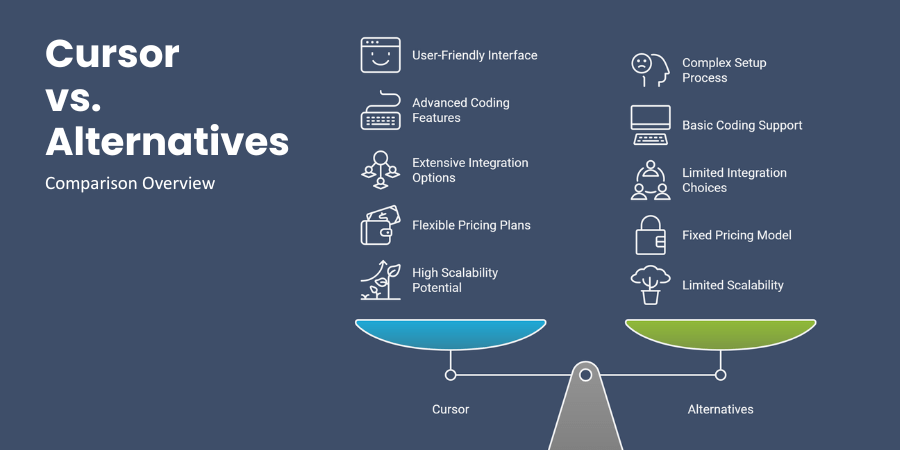
Ease of Use
Are you looking for a tool that feels intuitive from day one? Cursor offers a familiar experience for VS Code users, with minimal learning curve and straightforward adoption.
JetBrains AI Assistant excels if you are already comfortable in the JetBrains ecosystem, while Tabnine offers perhaps the most frictionless experience with minimal configuration required.
Codeium stands out for its simplicity and clean interface, making it particularly accessible if you are new to AI coding assistants and prefer straightforward interactions.
Coding Capabilities
Do you need comprehensive assistance across different coding tasks? Cursor provides strong general-purpose code generation and editing capabilities for diverse scenarios.
GitHub Copilot excels at generating complete functions and understanding project context, while JetBrains AI Assistant offers superior language-specific optimizations for code quality.
Tabnine focuses on shorter, more precise completions rather than generating entire functions, prioritizing accuracy in its suggestions.
Sourcegraph Cody stands out for its ability to answer questions about your codebase, making it invaluable for understanding complex systems.
Integration Ecosystem
How important is seamless integration with your existing tools? Cursor builds on VS Code, offering compatibility with most VS Code extensions and workflows.
JetBrains AI Assistant offers the deepest integration with JetBrains IDEs but limited options outside that ecosystem, potentially creating workflow constraints.
Amazon CodeWhisperer integrates well with AWS services and common IDEs, creating a cohesive experience for cloud development projects.
Pricing Structure
Are budget constraints influencing your decision? Cursor offers a freemium model with a generous free tier and premium features at $20/month for advanced capabilities.
JetBrains AI Assistant is included with JetBrains IDE subscriptions, potentially offering good value if you already use their tools in your development workflow.
Codeium stands out with its extensive free tier for individuals, making it an attractive option for independent developers and small teams.
Scalability for Teams
Will your chosen tool need to support growing team needs? Cursor offers team collaboration features but is still evolving its enterprise offerings and capabilities.
JetBrains AI Assistant benefits from the mature team collaboration features in JetBrains IDEs, supporting established team workflows effectively.
Amazon CodeWhisperer integrates with AWS’s enterprise-grade security and compliance features, making it suitable for organizations with strict requirements.
How to Choose the Right Cursor Alternative for Your Needs
Are you feeling overwhelmed by the options available? Finding the perfect alternative depends on understanding your specific requirements and development context.
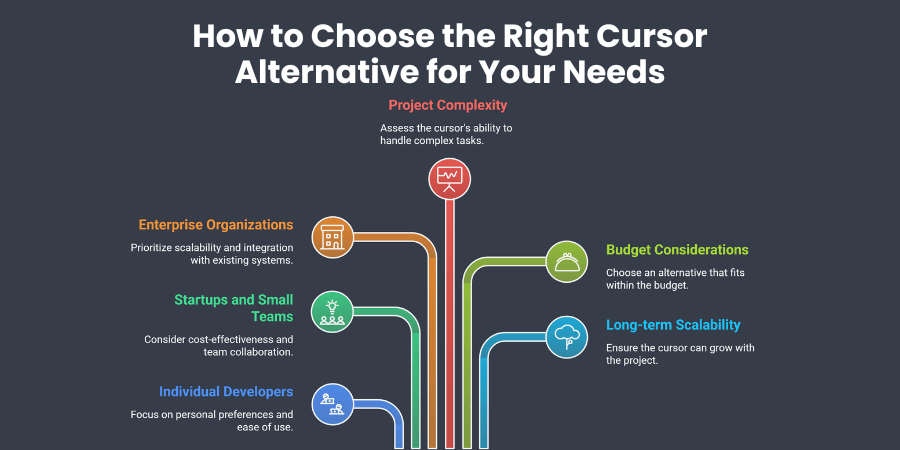
For Individual Developers
What type of development do you typically engage in? If you work across multiple languages and projects, consider tools with broad language support and versatility.
How important is cost to you? If you are budget-conscious, Codeium’s free tier offers exceptional value without significant functionality compromises.
Do you have specific privacy concerns? If you need to keep your code completely private, consider Tabnine’s local models that never transmit code externally.
What is your preferred development environment? Choose a tool that integrates seamlessly with your favorite IDE to maintain workflow continuity.
For Startups and Small Teams
How rapidly is your team growing? Look for tools with flexible pricing that scales reasonably as you add team members without unexpected cost increases.
Do you need collaborative features? Consider how each alternative supports shared knowledge and consistent coding practices across your expanding team.
What is your technology stack? Ensure your chosen alternative supports all languages and frameworks your team uses now and plans to adopt.
How important is onboarding time? Tools that feel familiar and require minimal training might help new team members become productive more quickly.
For Enterprise Organizations
Do you have specific security and compliance requirements? Amazon CodeWhisperer offers strong security features and AWS compliance certifications for regulated industries.
How will the tool integrate with your existing development infrastructure? Consider enterprise-grade tools that offer robust API access and integration capabilities.
What level of support do you require? Evaluate the support options for each alternative, including dedicated account managers and service level agreements.
How will you measure ROI? Consider tools that provide analytics on usage and productivity gains to justify the investment to stakeholders.
Project Complexity Considerations
Are you working on relatively simple projects? For straightforward development tasks, lighter-weight tools might provide sufficient assistance without unnecessary complexity.
Do you maintain large, complex codebases? For extensive projects, consider tools that excel at understanding broader project context and relationships.
Are you frequently learning new frameworks or languages? Tools with strong explanation capabilities might be particularly valuable for continuous learning.
Budget Considerations
What is your maximum budget per developer? Calculate the annual cost for each alternative and determine whether the productivity benefits justify the expense.
Do you prefer subscription or one-time payment models? Most AI coding assistants use subscription models, but the pricing structures vary significantly between options.
Are there educational or open-source project discounts available? Many providers offer special pricing for students or open-source contributors that could reduce costs.
Long-term Scalability
How might your needs evolve over time? Consider not just your current requirements but how each alternative positions you for future growth and adaptation.
What is the development roadmap for each alternative? Research recent updates and planned features to ensure your chosen tool continues to evolve appropriately.
How stable is the provider? Consider the financial backing and market position of each alternative to assess the likelihood of long-term support and development.
Conclusion
Have you discovered which Cursor alternative might best suit your unique development needs? Throughout this exploration, you have seen that several alternatives provide distinct advantages for specific use cases and development scenarios.
The right choice ultimately depends on your individual circumstances and priorities. Are you a solo developer seeking maximum flexibility, a startup building your first product, or an enterprise managing complex systems with specific compliance requirements?
Remember that the best tool is the one that feels natural in your workflow and effectively addresses your specific pain points. You might even find that using multiple tools in combination provides the optimal experience for different aspects of your development work.
I encourage you to take advantage of free trials and explore these alternatives hands-on before making a final decision. Nothing replaces direct experience with a tool in your actual development environment with your specific codebase.
Which alternative resonates most with your needs? Finding your perfect AI coding companion could transform your development experience in ways you have not yet imagined, boosting both productivity and code quality.
Frequently Asked Questions
Are Cursor Alternatives generally more expensive than Cursor itself?
Not necessarily. While Cursor offers a competitive freemium model, alternatives span the entire pricing spectrum. Codeium provides an extensive free tier that might meet all your needs. Your specific usage patterns will determine which option provides the best value for your situation.
Can I use multiple AI coding assistants together for different tasks?
Yes, you absolutely can combine different tools to leverage their unique strengths. Many developers use a primary assistant for day-to-day coding but switch to specialized alternatives for specific languages or tasks that require different capabilities.
How do these alternatives handle code privacy and security concerns?
Privacy approaches vary significantly between alternatives. Tabnine offers fully local models that never send your code to external servers. Before choosing an alternative, carefully review their privacy policies and security features to ensure alignment with your requirements.
Will these AI coding assistants eventually replace traditional programming skills?
No, these tools are best viewed as amplifiers of your existing programming knowledge rather than replacements. You still need strong fundamentals to effectively prompt, evaluate, and refine AI-generated code for optimal results.
How frequently are these alternatives updated with new features?
The AI coding assistant market is evolving rapidly, with most alternatives releasing significant updates every few months. Before committing to an alternative, check their recent update history and roadmap to ensure they demonstrate active development and improvement.
Shaif Azad
Related Post
Top 10 AI Development Companies in New Jersey for Business
Are you searching for the perfect AI development partner in New Jersey? Have you wondered which...
Top 10 AI Development Companies in New Hampshire
Are you watching New Hampshire’s tech landscape transform before your eyes? Your state is quietly becoming...
Top AI Companies in Nebraska Every Business Should Know
Are you a Nebraska business owner wondering how artificial intelligence could transform your operations? Picture this...




